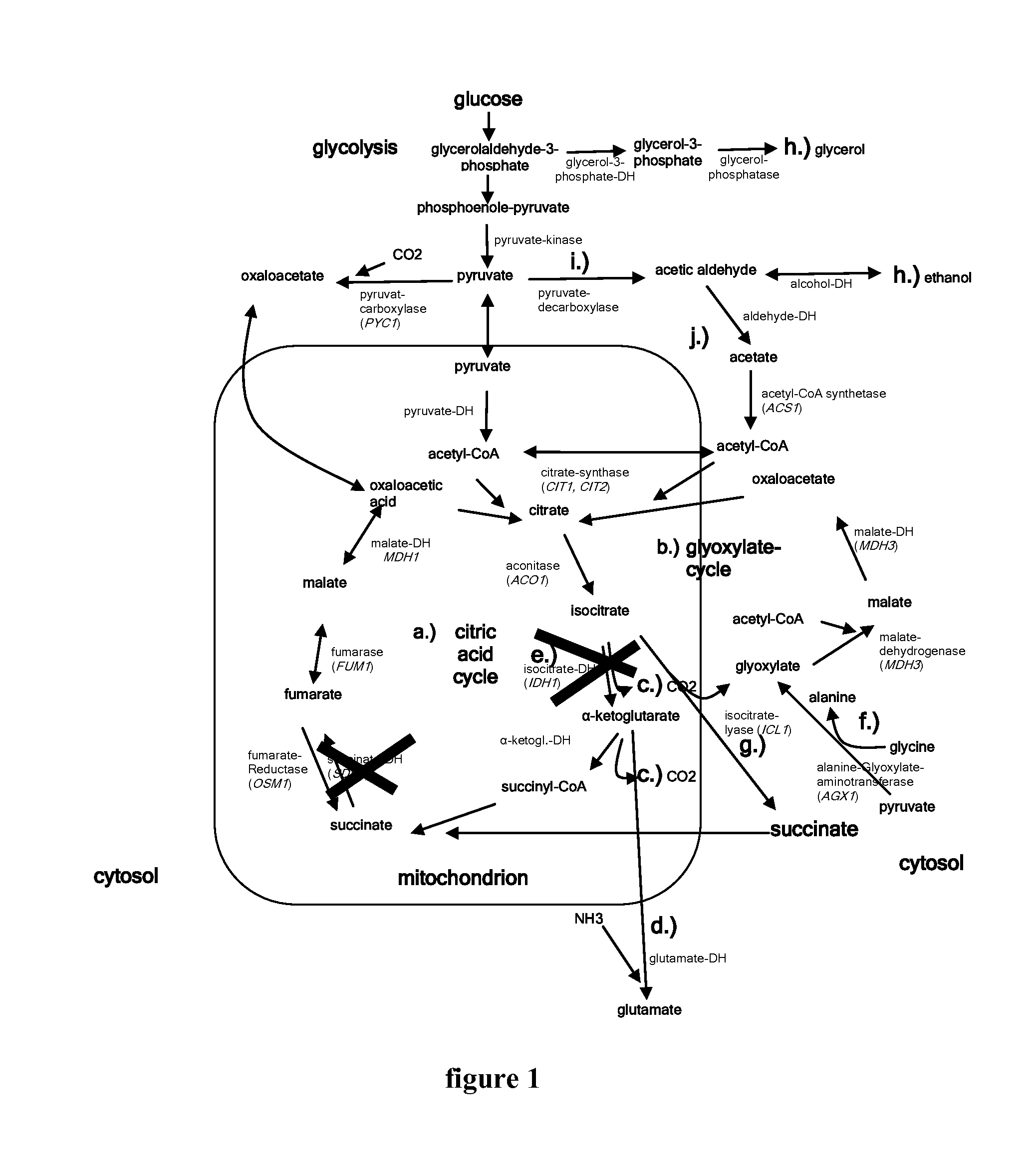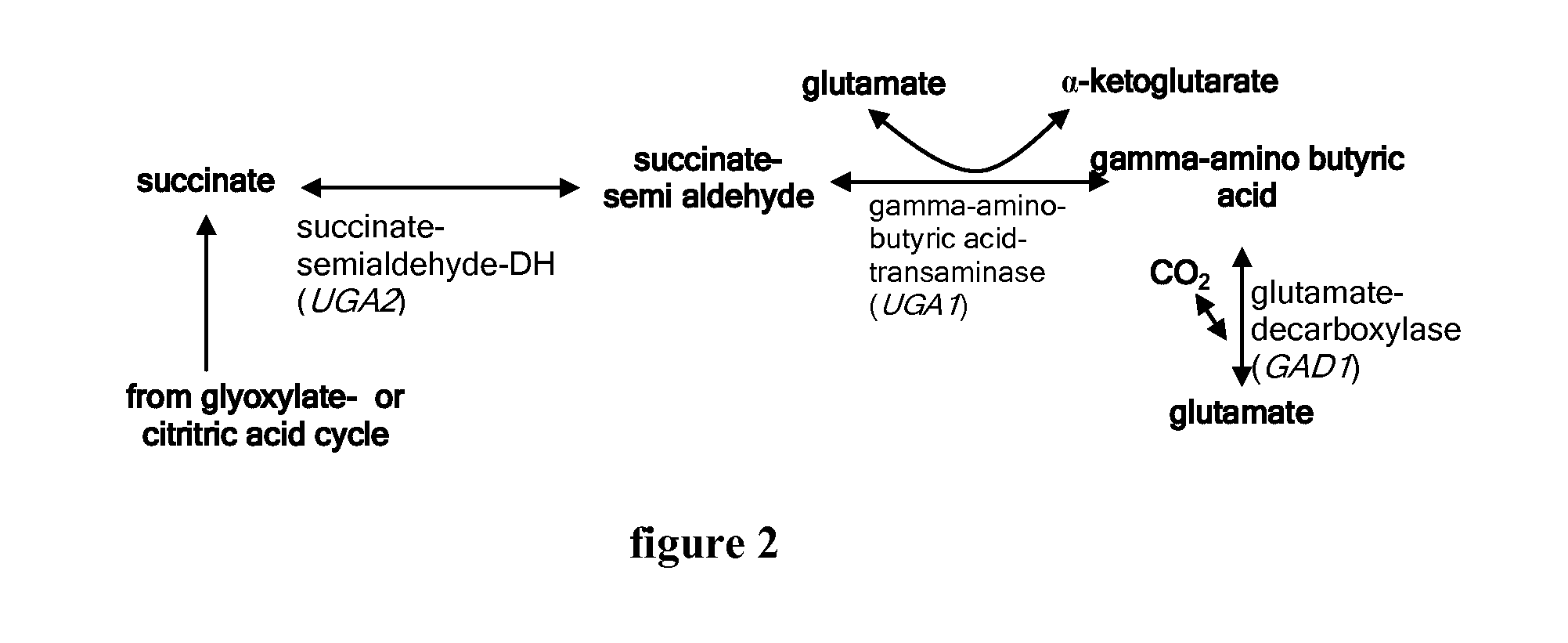Microorganism for producing succinic acid
a technology of succinic acid and microorganisms, applied in the field of microorganisms, can solve the problems of difficult to technically handle strictly anaerobic microorganisms, low biomass/product efficiency, and limited biomass production and production
- Summary
- Abstract
- Description
- Claims
- Application Information
AI Technical Summary
Benefits of technology
Problems solved by technology
Method used
Image
Examples
example1
Production of a Microorganism Using a Glyoxylate Cycle, which Transcriptionally and on the Protein Level is not Subject to the Glucose Repression for Producing Organic Acids of the Respiratory Central Metabolism, in Particular of Succinic Acid
[0051]Different enzymes of the citrate and glyoxylate cycle, the genes of which are transcriptionally suppressed by glucose, are subject in the yeast Saccharomyces cerevisiae also on the protein level to the regulation or inactivation by glucose. A transcriptional deregulation of these genes is therefore not sufficient for obtaining an active gene product. Thus, for a method for producing succinic acid being optimized with regard to production time and yields, inactivation effects on the protein level must also be prevented.
[0052]The glucose-induced proteolytic degradation or inactivation of the enzymes of the glyoxylate cycle can be prevented by expressing heterologous isoenzymes in the yeast Saccharomyces cerevisiae. These enzymes originate f...
example2
Production of a Microorganism for the Biotechnological Production of Succinic Acid and Other Organic Acids, which makes a More Efficient Production Process Possible by Reduction of Yield Losses
[0056]In order to reduce yield losses during the biotechnological production of succinic acid in the yeast Saccharomyces cerevisiae, succinic acid must be enriched as an end product and must not be further metabolized by the yeast cell. This cannot be achieved to full extent by the singular deletion of the gene sdh2. In addition, another subunit of the heterotetrameric enzyme succinate dehydrogenase, coded by the gene sdh1, must be deleted.
[0057]Yield losses may also result from the further metabolization of the formed succinates by the enzyme succinate-semialdehyde dehydrogenase. This enzyme is part of the glutamate degradation pathway and catalyzes the reaction of succinate to succinate-semialdehyde. This intermediate is then metabolized by gamma-amino butyric acid to glutamate. In this way,...
example3
Production of a Microorganism for the Biotechnological Production of Succinic Acid and Other Organic Acids, which Makes a Separation of Growth and Production Phases by Glutamate Supplementation Possible
[0072]In the following, a possibility of the separation of growth and production phases, which does not require the use of antibiotics, is described. In the yeast Saccharomyces cerevisiae, in spite of the deletions of the genes sdh2 and idh1, which lead to an interruption of the citrate cycle (see FIG. 1 black crosses), a growth rate can be measured that is comparable to an unmodified wild type yeast (in the 100 ml shake flask in YPD-medium, the strain AH22ura3Δsdh2Δidh1 has a growth rate that is only by 11% smaller, compared to the strain AH22ura3 (wild type), source: own data).
[0073]A growth of a yeast strain with an idh1 deletion is possible only because this deletion does not lead to a complete disappearance of the isocitrate dehydrogenase activity. The reason for this are 3 furth...
PUM
| Property | Measurement | Unit |
|---|---|---|
| time | aaaaa | aaaaa |
| time | aaaaa | aaaaa |
| time | aaaaa | aaaaa |
Abstract
Description
Claims
Application Information
 Login to View More
Login to View More - R&D
- Intellectual Property
- Life Sciences
- Materials
- Tech Scout
- Unparalleled Data Quality
- Higher Quality Content
- 60% Fewer Hallucinations
Browse by: Latest US Patents, China's latest patents, Technical Efficacy Thesaurus, Application Domain, Technology Topic, Popular Technical Reports.
© 2025 PatSnap. All rights reserved.Legal|Privacy policy|Modern Slavery Act Transparency Statement|Sitemap|About US| Contact US: help@patsnap.com


